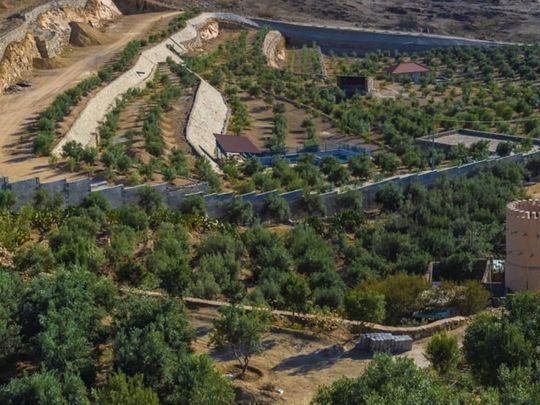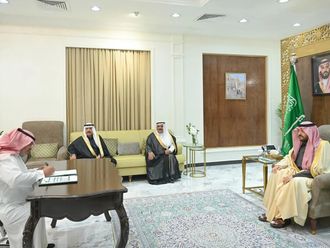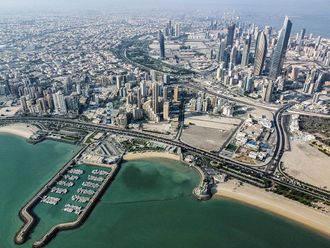
Abu Dhabi: In a province whose landscapes break all the stereotypes about Saudi Arabia beng made upp of endless sand dunes desert, with majestic mountains rising above 2,000 metres and covered by greenery, a Saudi citizen has started an olive tree farming business, the first in Al Bahah province, west of Saudi Arabia in the Hijaz area.
Dr. Saleh Bin Abbas Al Hafez reclaimed the farm on 150,000 square metres in the Buhr Centre on Al Aqeeq Road and cultivated 4,000 olive trees of 22 varieties, producing more than 10 tons of olive oil in addition to the fruit.
Attached to the farm, Al Hafez set up an olive press and a beekeeper to produce honey and reserves for some plants and birds and a stable for horses, in addition to three tanks to collect rain water for use in irrigation.
The Zaytouna Farm uses traditional agricultural terrace, as the 100 terraces, common along the Sarawat Mountains, were set up. Terrace farming is common on hilly or mountainous terrain. Terraced fields decrease both erosion and surface runoff, and may be used to support growing crops that require irrigation, such as rice.
Cultivation of olive trees began by planting seedlings ranging from one to three years old, four metres apart, and the maiden production in most trees came after five years, except for what is known as intensive olive, which is distinguished by its straight growth and high intensity of production from others. The farm hosts 22 varieties of olives.
Ancient business
The cultivation of the olive tree, Al Hafez says, is an ancient business that requires great passion and a lot of dedication.
“It includes some processing phases that are repeated every olive-growing season: fertilisation, pruning, defence, harvesting. These phases are very important for obtaining an excellent quality olive oil,” he adds.
In ancient times, he explained, the principle of oil extraction was based on the compression rupture of the drupes in stone mortars or crucibles obtained in the rock.
But as early as the 4th century BC the use of rotating wheels characterised by stone and wheel bases, with a wooden axis inserted in the centre to allow movement by humans or animals, has begun.
The processing of the olives in order to extract the oil, consists essentially in breaking the tissues of the fruit, turning it into a paste, to make the juice or oil come out. The solid residue that is obtained is called “sansa” and can be subjected to further chemical extraction.
Five phases
Al Hafez spelled out the five phases of the olive oil production.
“First, harvesting, which is the most delicate and decisive steps to obtain an excellent quality olive oil.
“Generally, it is facilitated with the use of nets lying on the ground under the plants that allow for easy collection of the fallen product or facilitated by any mechanical equipment.”
He added: “Second, washing and pressing. After harvesting, the olives are weighed and subjected to abundant washing in water. This process is carried out with a special washing machine with a constant flow of water.
The crushing system of the milled olives is the most ancient instrument, conceptually derived from the millstones used since the Hellenic times. Today, however, many mills use the most modern hammer crushers, which break the olives by pushing them violently against a metal grid.
“Third, kneading. After pressing, the olive paste is subjected to the kneading operation, which is a continuous and slow mixing of the dough.
The kneading phase is an essential moment for the subsequent extraction of the oil from the olive paste. In fact, the kneading allows the olive paste to reach optimal temperature in which the natural enzymes present are able to fully activate.
“Fourth, extraction. This phase is the separation of the oil from the solid fraction.
“Fifth, separation. In this final phase, we separate the olive oil from the water thanks to the centrifugal force,” he said.
The farm contains many trees, including rare ones such as jojoba tree, whose oils are used to care for the skin, and the ban tree with white flowers impregnated with pink, while the farm embraces about 12,000 seedlings to produce strawberries by hydroponics, and Dr. Al Hafez is working on cultivating renewable, green energy plants as well as grapes, figs and pomegranates. He also tries to use solar energy technologies on the farm. Zaitouna farm is the first tourist farm in Al Bahah, the Greenland of Saudi Arabia.
The word Bahah has many meanings; it means water and the maximum of it, the courtyard of a house, the high and abundant palm tree. In tales it refers to an extremely deep bottomless well in Al Zafir fortress.
Indeed, Al Bahah will surprise you not only with its majestic mountains rising above 2000 meters, which are covered by greenery, but also with its cool climate in summer.








